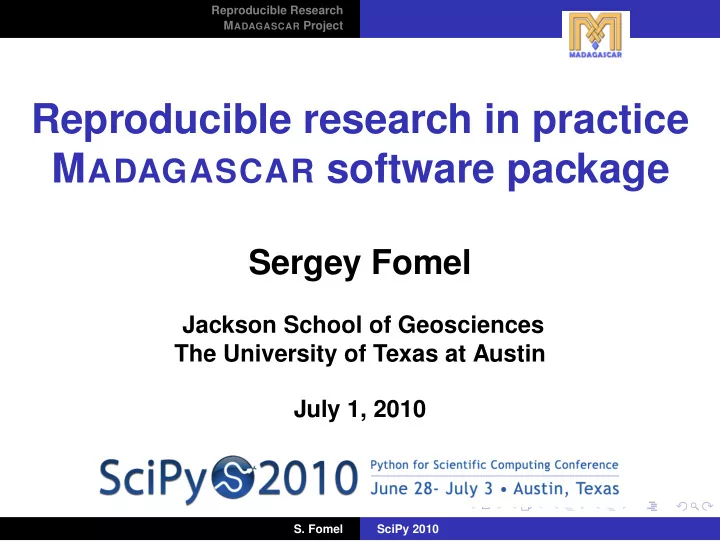

Reproducible Research M ADAGASCAR Project Reproducible research in practice M ADAGASCAR software package Sergey Fomel Jackson School of Geosciences The University of Texas at Austin July 1, 2010 S. Fomel SciPy 2010
Reproducible Research M ADAGASCAR Project Outline Reproducible Research M ADAGASCAR Project S. Fomel SciPy 2010
Reproducible Research M ADAGASCAR Project What is Science? S. Fomel SciPy 2010
Reproducible Research M ADAGASCAR Project What is Science? Science is the systematic enterprise of gathering knowledge about the universe and organizing and condensing that knowledge into testable laws and theories. The success and credibility of science are anchored in the willingness of scientists to independent testing and replication by other scientists. This requires the complete and open exchange of data, procedures and materials. American Physical Society, What is Science? S. Fomel SciPy 2010
Reproducible Research M ADAGASCAR Project What is Reproducible Research? ◮ Attaching software code and data to publications ◮ Communicating computational results to a skeptic An article about computational science in a scientific publication is not the scholarship itself, it is merely advertising of the scholarship. The actual scholarship is the complete software development environment and the complete set of instructions which generated the figures. Jon Buckheit and David Donoho, WaveLab S. Fomel SciPy 2010
Reproducible Research M ADAGASCAR Project Reproducible Research Discussions ◮ http://www.reproducibleresearch.net ICASSP 2007 Berlin-6 2008 CiSE 2009 ◮ Donoho et al. ◮ LeVeque ◮ Ping & Eckel ◮ Stodden IEEE Signal Processing Magazine 2009 ◮ Vandewalle et al. Yale Roundtable 2009 NSF Archive Workshop 2010 S. Fomel SciPy 2010
Reproducible Research M ADAGASCAR Project Personal Experience 1991–2001 Jon F . Claerbout ◮ Stanford Exploration Project ◮ Generations of Ph.D. students ◮ The principal beneficiary is the author 2003–Present M ADAGASCAR package ◮ Software code requires continuous maintenance ◮ Maintenance requires an open community S. Fomel SciPy 2010
Reproducible Research M ADAGASCAR Project Outline Reproducible Research M ADAGASCAR Project S. Fomel SciPy 2010
Reproducible Research M ADAGASCAR Project http://www.ahay.org/ ◮ Publicly released in 2006 (GPL) ◮ 1.0 release scheduled for July 2010 ◮ School and Workshop in Houston on July 23-24, 2010 ◮ http://www.ahay.org/wiki/Houston 2010 ◮ 25+ developers ◮ 250,000+ lines of code (20% Python) ◮ 10,000+ downloads from SourceForge ◮ 80 reproducible papers; 3,000 reproducible results ◮ http://www.ahay.org/wiki/Reproducible Documents S. Fomel SciPy 2010
Reproducible Research M ADAGASCAR Project Thanks ◮ Vladimir Bashkardin, Jules Browaeys, William Burnett, Cody Brown, Maria Cameron, Lorenzo Casasanta, Joseph Dellinger, Jeff Godwin, Gilles Hennenfent, Trevor Irons, Jim Jennings, Long Jin, Roman Kazinnik, Siwei Li, Guochang Liu, Yang Liu, Doug McCowan, Henryk Modzelewski, Colin Russell, Paul Sava, Jeffrey Shragge, Xiaolei Song, Eduardo Filpo Silva, Ioan Vlad, Jia Yan, Lexing Ying S. Fomel SciPy 2010
Reproducible Research M ADAGASCAR Project M ADAGASCAR design ◮ Multidimensional arrays as file objects ◮ Simple universal file format ◮ ASCII header file + data ◮ Filter programs to transfer files ◮ C, C++, Fortran, Java, Matlab, Python ◮ Combined with pipes and scripts ◮ “ Write programs that do one thing and do it well. Write programs to work together. Write programs to handle text streams, because that is a universal interface.” Doug McIlroy S. Fomel SciPy 2010
Reproducible Research M ADAGASCAR Project M ADAGASCAR filter in Python #!/ usr/bin/env python import numpy import m8r par = m8r.Par () input = m8r.Input () output = m8r.Output () n1 = input.int("n1") # trace length n2 = input.size (1) # number of traces clip = par.float("clip") trace = numpy.zeros(n1 ,’f’) for i2 in xrange(n2): # loop over traces input.read(trace) trace = numpy.clip(trace ,-clip ,clip) output.write(trace) S. Fomel SciPy 2010
Reproducible Research M ADAGASCAR Project M ADAGASCAR filter in C #include <rsf.h> int main(int argc , char* argv []) { int n1 , n2 , i1 , i2; float clip , *trace; sf_file in , out; sf_init(argc ,argv ); in = sf_input("in"); out = sf_output("out"); sf_histint(in ,"n1" ,&n1); /* trace length */ n2 = sf_leftsize(in ,1); /* number of traces */ if (! sf_getfloat ("clip" ,&clip )) sf_error("Need clip="); trace = sf_floatalloc (n1); for (i2 =0; i2 < n2; i2 ++) { sf_floatread (trace ,n1 ,in); for (i1 =0; i1 < n1; i1 ++) { if (trace[i1] > clip) trace[i1]= clip; else if (trace[i1] < -clip) trace[i1]=-clip; } sf_floatwrite (trace ,n1 ,out); } exit (0); } S. Fomel SciPy 2010
Reproducible Research M ADAGASCAR Project M ADAGASCAR script in Python >>> import m8r >>> spike = m8r.spike(n1 =1000 , n2 =100)[0] >>> spike <m8r.File object at 0x4038b10 > >>> m8r.clip(clip =0.5) <m8r.Filter object at 0x9976690 > >>> cliped = m8r.clip(clip =0.5)[ spike] >>> cliped2 = m8r.spike(n1 =1000 , n2 =100). clip(clip =0.5)[0] >>> import numpy >>> cliped = numpy.clip(spike , -0.5 ,0.5) bash$ sfspike n1 =1000 n2 =100 > spike.rsf bash$ < spike.rsf sfclip clip =0.5 > cliped.rsf bash$ sfspike n1 =1000 n2 =100 | sfclip clip =0.5 > cliped2.rsf S. Fomel SciPy 2010
Reproducible Research M ADAGASCAR Project M ADAGASCAR SConstruct script from rsf.proj import Flow Flow(’spike ’,None ,’spike n1 =1000 n2 =100 ’) Flow(’cliped ’,’spike ’,’clip clip =0.5 ’) bash$ scons scons: Building targets ... sfspike n1 =1000 n2 =100 > spike.rsf < spike.rsf sfclip clip =0.5 > cliped.rsf scons: Done building targets. bash$ sed s/0.5/0.25/ < SConstruct > SConstruct2 bash$ mv SConstruct2 SConstruct bash$ scons scons: Building targets ... < spike.rsf sfclip clip =0.25 > cliped.rsf scons: Done building targets. ◮ http://www.scons.org/ S. Fomel SciPy 2010
Reproducible Research M ADAGASCAR Project Conclusions ◮ Reproducible research ◮ Attaching software and data to publications ◮ Computational experiments communicated to a skeptic ◮ Continuous maintenance requires an open community ◮ M ADAGASCAR project ◮ Practical implementation of reproducible research ◮ Multidimensional arrays as file objects ◮ Glued together by Python S. Fomel SciPy 2010
Recommend
More recommend